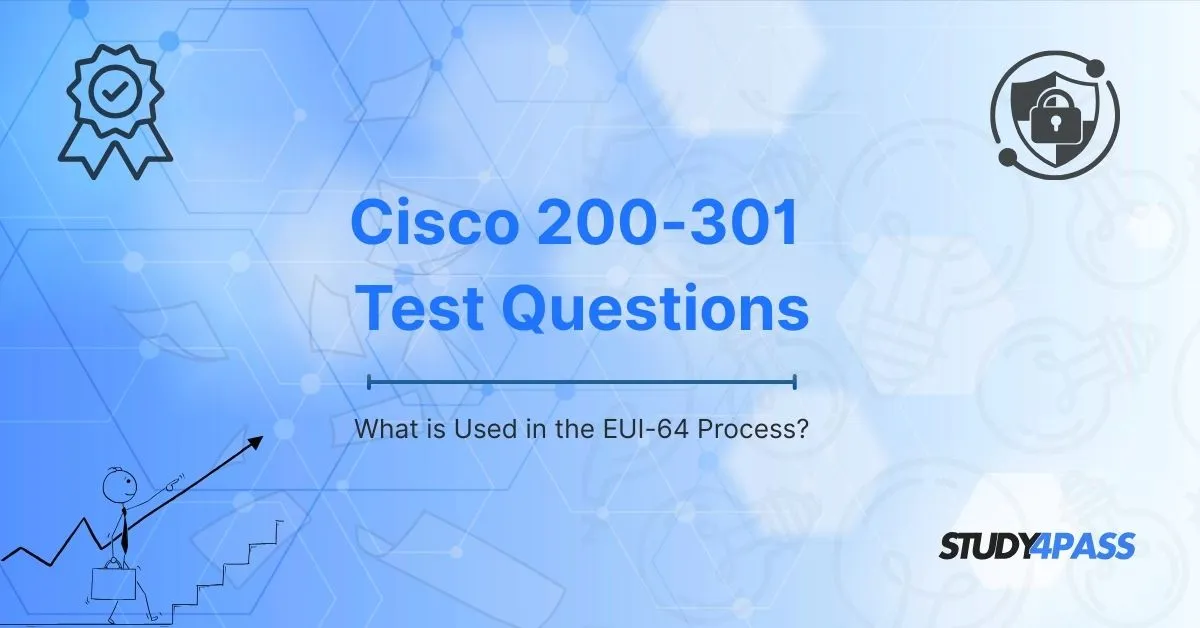Introduction To Cisco 200-301 Test Questions
Preparing for the Cisco 200-301 exam requires a deep understanding of key networking concepts, including IPv6 addressing and the EUI-64 process. If you're searching for reliable Cisco 200-301 test questions, mastering EUI-64 is essential, as it plays a crucial role in IPv6 autoconfiguration.
In this blog, we’ll explore:
What the EUI-64 process is
- What components are used in EUI-64
- How it works in IPv6 addressing
- Why it’s important for the Cisco 200-301 exam
- Practice questions to test your knowledge
By the end, you’ll have a solid grasp of EUI-64, helping you confidently tackle related Cisco 200-301 Test Questions.
What is the EUI-64 Process?
The Extended Unique Identifier-64 (EUI-64) process is a method used in IPv6 to automatically generate a 64-bit interface identifier (IID) from a device’s 48-bit MAC address. This allows devices to configure their IPv6 addresses without manual input or DHCP.
Why is EUI-64 Important?
- Enables stateless address autoconfiguration (SLAAC) in IPv6.
- Ensures uniqueness of IPv6 addresses.
- Reduces manual configuration errors.
- Since IPv6 addresses are 128 bits long, they are divided into:
- 64-bit network prefix (assigned by the router).
- 64-bit interface identifier (generated via EUI-64).
What is Used in the EUI-64 Process?
To generate an IPv6 interface ID using EUI-64, the following components are used:
1. The Device’s MAC Address (48 Bits)
- A MAC address is 6 bytes (48 bits) long, written in hexadecimal (e.g., `00:1A:2B:3C:4D:5E`).
- The first 24 bits represent the OUI (Organizationally Unique Identifier).
- The last 24 bits represent the NIC (Network Interface Controller) portion.
2. Inserting FFFE in the Middle
- The MAC address is split into two 24-bit halves.
- The hex value FFFE (16 bits) is inserted in between.
Example:
Original MAC: `00:1A:2B:3C:4D:5E`
After inserting FFFE: `00:1A:2B:FF:FE:3C:4D:5E`
3. Flipping the 7th Bit (Universal/Local Bit)
The 7th bit in the first byte of the MAC address is inverted.
This bit indicates whether the address is universally unique (0) or locally administered (1).
Example Calculation:
- First byte of MAC: `00` (binary: `00000000`)
- Flip the 7th bit: `00000010` (binary) → `02` (hex)
- Final modified first byte: `02`
- Final EUI-64 Interface ID
- Using the previous example:
- Original MAC: `00:1A:2B:3C:4D:5E`
- Modified MAC with FFFE: `02:1A:2B:FF:FE:3C:4D:5E`
- Final 64-bit IID: `021A:2BFF:FE3C:4D5E`
4. Combining with IPv6 Prefix
- The router advertises the 64-bit network prefix (e.g., `2001:0DB8:ACAD::/64`).
- The device appends its EUI-64 IID to form the full IPv6 address:
- `2001:0DB8:ACAD::021A:2BFF:FE3C:4D5E`
Why is EUI-64 Relevant for Cisco 200-301 Test Questions?
The Cisco 200-301 exam tests your understanding of IPv6, including:
- IPv6 address structure
- Stateless address autoconfiguration (SLAAC)
- EUI-64 process steps
- Expect questions like:
What is inserted into a MAC address to create an EUI-64 interface ID?
Answer: FFFE
Which bit is flipped in the EUI-64 process?
Answer: The 7th bit (U/L bit)
How is an IPv6 address generated using EUI-64?
Mastering these concepts ensures you can answer Cisco 200-301 Certification confidently.
Conclusion
Understanding the EUI-64 process is crucial for IPv6 addressing and the Cisco 200-301 exam. By knowing how a MAC address is converted into a 64-bit interface ID, you can confidently answer related Cisco 200-301 test questions.
Special Discount: Offer Valid For Limited Time “200-301 Exam Prep Practice Tests”
Sample Questions for Cisco 200-301 Exam Prep Practice Test
Actual exam question from Cisco's 200-301 Exam
Which protocol is used by routers to dynamically learn the best path to forward packets?
A) HTTP
B) FTP
C) OSPF
D) SMTP


